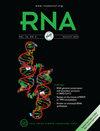The antivirulent Staphylococcal sRNA SprC regulates CzrB efflux pump to adapt its response to Zinc toxicity
IF 4.2
3区 生物学
Q2 BIOCHEMISTRY & MOLECULAR BIOLOGY
引用次数: 0
Abstract
Bacterial regulatory RNAs (sRNAs) are important players to control gene expression. In S. aureus, SprC is an antivirulent trans-acting sRNA known to base-pair with the major autolysin atl mRNA, preventing its translation. Using MS2-affinity purification coupled with RNA sequencing (MAPS), we looked for its sRNA-RNA interactome and identified fourteen novel mRNA targets. In vitro biochemical investigations revealed that SprC binds two of them, czrB and deoD, and uses a single accessible region to regulate its targets, including Atl translation. Unlike Atl regulation, the characterization of the SprC-czrB interaction pinpointed a destabilization of czrAB co-transcript,leading to a decrease of the mRNA level that impaired CzrB Zinc efflux pump expression. On a physiological stand-point, we showed that SprC expression is detrimental to combat against Zinc toxicity. In addition, phagocyctosis assays revealed a significant, but moderate, increase of czrB mRNA level in a sprC-deleted mutant, indicating a functional link between SprC and czrB upon internalization in macrophages, and suggesting a role in resistance to both oxidative and Zinc burst. Altogether, our data uncover a novel pathway in which SprC is implicated, highlighting the multiple strategies employed by S. aureus to balance virulence using an RNA regulator.抗病毒葡萄球菌 sRNA SprC 可调控 CzrB 外排泵,使其适应锌毒性反应
细菌调控 RNA(sRNA)是控制基因表达的重要角色。在金黄色葡萄球菌中,SprC 是一种抗病毒反式作用 sRNA,已知能与主要自溶蛋白 atl mRNA 碱基配对,阻止其翻译。利用 MS2 亲和纯化和 RNA 测序(MAPS)技术,我们研究了它的 sRNA-RNA 相互作用组,并确定了 14 个新的 mRNA 靶标。体外生化研究发现,SprC 与其中的两个靶标(czrB 和 deoD)结合,并利用单个可访问区域来调控其靶标,包括 Atl 翻译。与 Atl 的调控不同,SprC-czrB 相互作用的特点是破坏了 czrAB 共转录本的稳定性,导致 mRNA 水平下降,从而损害了 CzrB 锌外排泵的表达。从生理学角度来看,我们发现 SprC 的表达不利于对抗锌的毒性。此外,吞噬作用实验表明,在一个缺失了 sprrC 的突变体中,czrB mRNA 水平有显著但适度的增加,这表明 SprC 和czrB 在巨噬细胞内化时存在功能性联系,并表明 SprC 在抵抗氧化和锌猝灭中的作用。总之,我们的数据揭示了 SprC 参与其中的新途径,突出了金黄色葡萄球菌利用 RNA 调节器平衡毒力的多种策略。
本文章由计算机程序翻译,如有差异,请以英文原文为准。
求助全文
约1分钟内获得全文
求助全文
来源期刊

RNA
生物-生化与分子生物学
CiteScore
8.30
自引率
2.20%
发文量
101
审稿时长
2.6 months
期刊介绍:
RNA is a monthly journal which provides rapid publication of significant original research in all areas of RNA structure and function in eukaryotic, prokaryotic, and viral systems. It covers a broad range of subjects in RNA research, including: structural analysis by biochemical or biophysical means; mRNA structure, function and biogenesis; alternative processing: cis-acting elements and trans-acting factors; ribosome structure and function; translational control; RNA catalysis; tRNA structure, function, biogenesis and identity; RNA editing; rRNA structure, function and biogenesis; RNA transport and localization; regulatory RNAs; large and small RNP structure, function and biogenesis; viral RNA metabolism; RNA stability and turnover; in vitro evolution; and RNA chemistry.
 求助内容:
求助内容: 应助结果提醒方式:
应助结果提醒方式:


